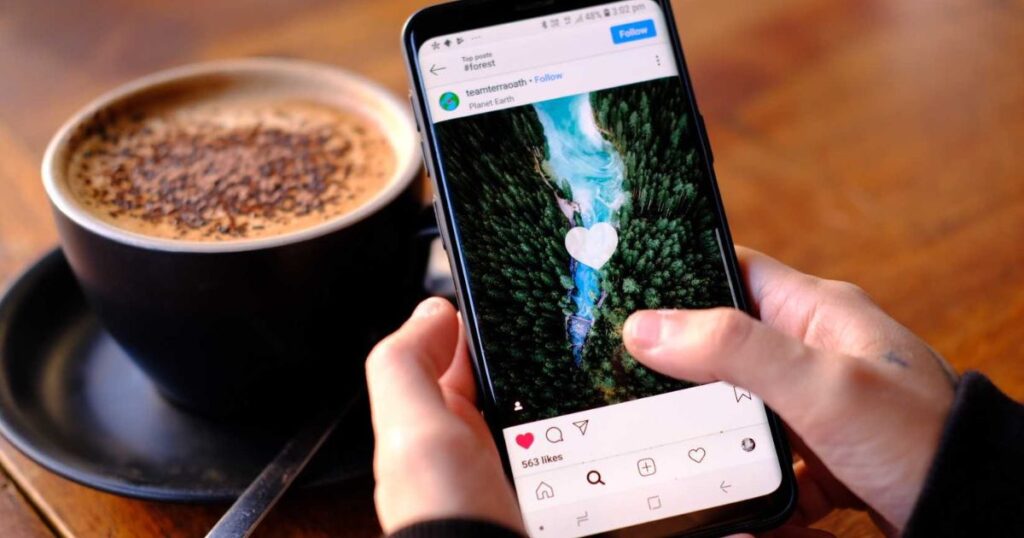Introduction
Instagram is one of the most important social media platforms today. According to Statista, in 2022, Instagram had 1.28 billion monthly active users, who spend a very long time on the Instagram app. Statista also found that people spend on average 147 minutes per day on social media.
What started out as a platform to share pictures with beautiful filters with friends, has turned into one a place where people follow celebrities, learn about different topics, entertain themselves, and discover new brands.
Brands that want to stand out must have a significant number of followers. This in turn serves two purposes – increasing brand awareness and providing social proof. Social proof is important to establish trust with potential customers and convert them into paying customers.
There are several ways to grow the number of real people who follow your Instagram account. One way would be organic growth, through collaborations with other brands and giveaways. Another option would be by paying influencers to promote your brand.
In this article, I’ll discuss a third option – using Facebook ads to get new Instagram followers.
- Introduction
- Understanding the Connection between Facebook and Instagram
- Choosing the right campaign type
- Targeting the right people
- Ad placements
- Creatives and content: Creating the ads
- Landing Page
- Setting Up Facebook Ads for Instagram Growth
- Analyzing results and optimizing your campaign
- Conclusion
- Further Reading:
Understanding the Connection between Facebook and Instagram
Instagram was bought by Facebook in 2012, for a then staggering amount of $1 billion! Following this purchase, Facebook added Instagram placements to its advertising platform, and until today, advertisers who want to advertise on Instagram use the Facebook Ads Manager.

Within the ads manager, advertisers can choose whether they’d like to advertise only on Facebook, only on Instagram, or on both platforms at the same time. This flexibility has become very valuable as differences between the user bases on both platforms increased over time (Facebook audience is considered older).
Managing ads for the two platforms from a single interface is super convenient, and allows for synergies, e.g. targeting a lookalike audience, recent visitors, or customers on both platforms.
Using Facebook advertising is available to anyone with a Facebook account. You just need to search for the Ads Manager link in the left-hand menu on Facebook. Your personal Facebook account can be linked to your Facebook page and Instagram business account, as well as to your brand’s ad account.
Choosing the right campaign type
Facebook Ad offers many campaign types, to achieve the various objectives of different advertisers. Ecommerce brands often opt for conversion campaigns, while B2B tools and services will probably use lead-generation campaigns. Traffic campaigns are a great way for driving cheap website traffic, while engagement campaigns can help get more likes and comments on your Instagram posts.
Unfortunately (or maybe not), there’s no campaign objective to increase Instagram followers. That would too easy… This means digital marketers need to be creative and use a workaround.
The best way to create a campaign with the objective of growing your Instagram following is to use a traffic campaign.
Targeting the right people
Who you target in your campaign will have a huge impact on the success of your campaign. However, your approach will depend on your current status.
In all cases, make sure that you target only the relevant geographical area – country, state, or city.
You should also exclude your current followers in the ad set level. Targeting them would be a waste of money.
Current status: You already have many Instagram followers
The best option would be to create a 1% lookalike audience of them and serve your ads to this audience.
Lookalike audiences are generated by Facebook, to find users who are statistically close to those in your source data. It can be followers, customers, visitors, etc.
The bigger your Instagram audience is, the better performance you’ll see from the lookalike audience. As a rule of thumb, use this approach when you have at least 10,000 followers already.
Current status: You have many customers, but not enough Instagram followers
While your customers aren’t necessarily the same target group that would follow you on social media, if you have many customers there’s a high probability to find new followers among them.
Create a 1% lookalike of your customers based on an Email list. Also here, the bigger your database, the better. It’s also a good idea to create a retargeting audience of recent visitors to your website, as well as an audience of people who like your Facebook page and target them.
Current status: You’re only starting out
In this case, use Facebook’s targeting options to target Instagram users by geography, demographics, interests (the products that you’re selling or your competitors), or behavior (recent visitors to your website).
Make sure you’re not adding too many criteria so your audience isn’t too small. The smaller the audience, the more expensive it will be to target. The KPI for this metric is called Cost per Mille, or CPM. This would be the cost of 1,000 ad impressions.

Ad placements
As we’re looking to win new followers, it only makes sense to only run the ads on Instagram. Running our campaign on Facebook and sending users to our Instagram page might feel less natural, and impact the results.
While starting the Instagram ads campaign, I’d suggest running the ads on both Instagram feeds and stories. Based on the results, you can decide whether it makes sense to continue or exclude one of them later.
As Instagram stories and reels have become more popular over the past couple of years, and based on initial results, we might consider excluding the feed placement.
Creatives and content: Creating the ads
Crafting a good ad is an art. Online marketers need to take into consideration so many things, some tangible and some more theoretical. Here are some best practices for creating a good ad creative and getting the best results.
1. Visual Appeal
The ad should feature eye-catching imagery or videos that capture attention and get the user’s attention for long enough to hear the value proposition.
2. Relevance
The ad creative should align with the target audience’s interests, preferences, and demographics. It should speak to their needs, desires, or pain points, making it more relatable and compelling.
3. Clear Message
A good ad creative communicates its message clearly and concisely. It should convey the value proposition or main benefit of the product or service being advertised. In video ads, this message should come right at the start, before users swipe to the next story.
4. Unique Selling Point (USP)
Highlighting what sets the product or service apart from competitors is crucial. The ad creative should emphasize the unique features, benefits, or value that the audience can expect, making it stand out from the crowd.
5. Call-to-Action (CTA)
A strong and compelling CTA prompts viewers to take the desired action. In our case, the CTA of a video ad should be ‘follow us for more’. For image ads, Facebook offers several CTA buttons to choose from, ‘learn more’ would be the most appropriate.
6. Brand Consistency
The ad creative should align with the brand’s identity, including its logo, colors, fonts, and overall tone. Consistency across all marketing materials helps build brand recognition and trust among the audience.
It’s also recommended to always run some A/B tests. It could be testing which audience performs better, which placement, or which creative.
So make sure you create several versions of your ads, in different formats. Your ad versions could include different dimensions for feed and story placements, and feature a different speaker for videos or images for static image ads.
Try to identify a winner from every test, and then run a new creative against it.
Landing Page
The landing page of your ads will be the URL of your brand’s Instagram business profile.
Note that as you can’t implement a Facebook pixel on Instagram pages, you will not be able to track any actions but ad clicks. In order to measure your campaign’s impact on the number of followers, you’ll have to compare the numbers before and after your campaign.
Before you start running your ads, make sure that your Instagram profile has enough high-quality, compelling posts and reels before you start the campaign. No one will follow a poor-looking page.
Ideally, you should start running this campaign when you already have some followers, at least 1000 to begin with. People don’t like walking into empty stores.
If you’re not there yet, try making it clear that you’re new in the market.
Setting Up Facebook Ads for Instagram Growth
Now that we’ve covered all of the important elements, we can put them into a step-by-step guide, ordered by campaign, ad set, and ad level:
- Campaign:
- Create a new campaign with the traffic objective
- Set up daily/ lifetime budget (campaign budget optimization – CBO)
- Ad Set:
- Define your geo-targeting
- Include your audience (create a new audience in the audience manager if necessary)
- Exclude existing followers
- Only target Instagram placements – feed and story
- Ads:
- Make sure your ads are visually appealing, and convey your value proposition within no more than 3 seconds
- AB test different ad creative – 2-3 at a time. If you can identify a winner, double down on it and run a new creative against it.

Analyzing results and optimizing your campaign
After your Facebook ads campaign has run for a few days and spent some money, it’s time to see if it works, and how we can optimize it to improve our results.
But first, ask yourself – have you gathered enough data to make a good data-based decision? Are the differences in performance between the audiences or ads significant enough to pick a winner? Or could 10 additional clicks change the whole picture?
Once you’ve established that you have enough data, make sure you focus on the metrics that matter most. In our case, as we’re running a traffic campaign, a Click-Through-Rate (CTR) would be a good indicator for a good ad creative, and would affect the CPC.
But we shouldn’t forget that our main goal is to increase our followers. This means we have to check the difference in the number of followers since we started the campaign. Dividing the delta by the amount we spent would give us our Cost per Follower. Is it good or bad? That’s for you to decide.
In order to measure the Cost per follower or a specific audience or ad placement, we must run them alone. This could be part of an A/B testing roadmap, which defines the order of elements we plan to test – audience, ad placement, geography, creatives, USP, etc. A/B testing is an essential part of every ad optimization process and one of the best ways to improve campaign results over time.
Conclusion
With Instagram being one of the most important platforms for brands, many look to grow the number of their followers. Facebook ads are a powerful tool to help brands win new followers on Instagram.
Except from increasing brand awareness and obtaining permission to communicate to the target audience, a high number of followers is a strong signal of social proof, which helps convert prospects into paying customers.
Further Reading:
- Google Ads vs. Facebook Ads For Ecommerce: Which Advertising Platform Is Better For Your Business?
- How Long Does It Take For Facebook Ads To Optimize?
- PPC vs. SEO: Which One Is Better? Pros, Cons, And When To Use Which
- How to Craft a Powerful Value Proposition on Google Display Ads
- Marketing Vs. Advertising Vs. Branding – Differences Explained
- Facebook Ad Testing: A/B Test To Improve Your Results

